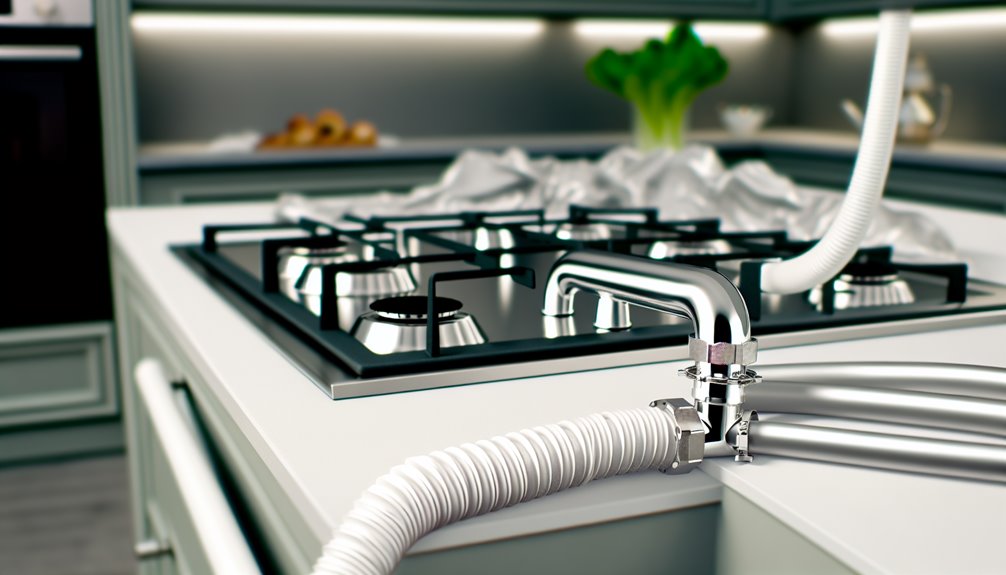To securely run a gas line for your kitchen stove, start by understanding gas line basics and local regulations. Assess your kitchen layout for proper appliance spacing. Choose between flexible tubing or rigid piping based on your needs. Make sure you follow safety measures during installation, like using proper fittings and checking for leaks. Regular testing and maintenance are essential for safe operation. There’s much more to take into account for a safe setup and best performance.
Key Takeaways
- Assess kitchen layout and ensure the stove is at least 30 inches from walls for safety and functionality.
- Choose between flexible tubing for tight spaces or rigid piping for durability based on local codes and stove requirements.
- Obtain necessary permits and adhere to local safety regulations before starting the gas line installation.
- Securely connect all fittings and use a soap-and-water solution to check for leaks during installation.
- Perform regular visual inspections and leak detection tests, with professional check-ups every two years for safety.
Understanding Gas Line Basics
When it comes to running a gas line for your kitchen stove, understanding the basics is vital.
You’ll encounter various gas line types, including flexible and rigid options. Flexible lines are easier to install and work well in tight spaces, while rigid lines offer durability and are ideal for long runs.
It’s important to know the gas pressure requirements for your stove, as this impacts performance and safety. Generally, most kitchen stoves require a standard pressure of 7 inches water column for natural gas and 11 inches for propane.
Before starting your project, familiarize yourself with local codes and regulations to guarantee compliance. This knowledge will help you make informed decisions and create a safe and efficient gas line setup.
Assessing Your Kitchen Layout
Before installing the gas line, evaluating your kitchen layout is key. Start by measuring your kitchen dimensions to guarantee that you have enough space for your stove and other appliances. Consider the appliance placement, as it’ll affect both functionality and safety. Here’s a simple table to help you visualize your layout:
| Appliance | Recommended Distance |
|---|---|
| Stove | 30 inches from walls |
| Refrigerator | 36 inches from stove |
| Oven | 12 inches from stove |
| Sink | 36 inches from stove |
| Dishwasher | 24 inches from sink |
Choosing the Right Gas Line Materials
Selecting the right materials for your gas line is essential not just for safety but also for the efficiency of your kitchen stove.
You’ll typically choose between flexible tubing and rigid piping. Flexible tubing is easier to install and can navigate tight spaces, making it a great option for complex kitchen layouts.
However, rigid piping offers superior durability and is often preferred for long runs or where high-pressure is involved.
When deciding, consider your specific needs, local codes, and the stove’s requirements. Always consult with a professional if you’re unsure, as using the wrong material can lead to leaks or inefficiencies.
Ultimately, the right choice guarantees a safe and efficient kitchen environment.
Installation Process and Safety Measures
Once you’ve chosen the right materials for your gas line, it’s time to focus on the installation process and safety measures. First, check local safety regulations and obtain any necessary installation permits. This guarantees your work complies with local codes and standards.
When installing the gas line, always wear protective gear and work in a well-ventilated area.
Securely connect fittings and confirm there are no leaks by using a soap-and-water solution to check for bubbles. If you spot any, tighten connections or replace faulty parts.
Testing and Maintenance of Gas Lines
To guarantee your gas line operates safely and efficiently, regular testing and maintenance are essential. This guarantees gas line safety and helps you detect any leaks early. Here’s a quick guide to help you stay on track:
| Task | Frequency |
|---|---|
| Visual Inspection | Monthly |
| Leak Detection Test | Every 6 months |
| Pressure Test | Annually |
| Professional Check-Up | Every 2 years |
| Replace Old Lines | As needed |
Frequently Asked Questions
Can I Run a Gas Line Myself, or Should I Hire a Professional?
You can attempt a DIY installation, but safety considerations are essential. If you’re not confident in your skills or knowledge, hiring a professional guarantees your gas line’s safe and compliant with local regulations.
What Are the Signs of a Gas Leak in My Kitchen?
If you suspect a gas leak in your kitchen, look for a gas odor or hissing sounds. These signs indicate a potential problem, and you should act quickly by evacuating and calling a professional immediately.
How Often Should I Have My Gas Line Inspected?
You should schedule frequency inspections of your gas line at least once a year. Regular checks guarantee compliance with safety standards and help prevent potential hazards, keeping your home safe and your family secure.
What Is the Average Cost to Install a Gas Line?
The average cost to install a gas line varies based on installation factors like location and complexity. You’re looking at a cost breakdown of materials, labor, and permits, typically ranging from $300 to $1,000.
Are There Specific Regulations for Gas Line Installation in My Area?
Yes, there’re specific regulations for gas line installation in your area. You’ll need to check local codes and obtain installation permits to guarantee your project complies with safety standards and legal requirements.



